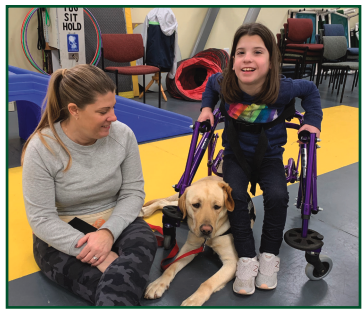The work Service Dogs perform every day is cause for celebration, and this September—National Service Dog Month—we honor them for the incredible job they do every day. Service Dogs are as essential to someone dealing with a disability as a wheelchair is to a person who is unable to walk or an insulin pump is to a person with diabetes. Like those medical devices, Service Dogs enable people to be independent and enjoy a better quality of life, and, most importantly, be safe. In some cases, they can be the difference between life and death.

The world is an unpredictable place. The pandemic made that crystal clear in 2020. Despite our best efforts to stay out of harm’s way, things can happen immediately and drastically change our lives. No one plans on becoming disabled. People don’t anticipate being in an accident. Nobody sets out to be diagnosed with severe disease. But those things do happen to thousands of people who never thought it would happen to them. Thankfully, for many of those who have endured those experiences, highly-skilled Service Dogs make it possible for them to lead safe, independent lives.
If you haven’t been personally affected, it’s hard to fully comprehend the life-changing impact a Service Dog can have on a person’s life. We can understand the importance of Service Dogs intellectually. Still, unless we, or someone we love, rely on a Service Dog to function better in the world, it’s nearly impossible to grasp the enormous difference they make.
Guide dogs for the visually impaired and hearing dogs for the hearing impaired are the most widely known types of Service Dogs, but there are many other types of Service Dogs:

Mobility Assistance Service Dogs can perform a wide range of tasks for people with mobility issues, such as bringing objects to people or pressing buttons on automatic doors. They can also serve as a brace for ambulatory people or even help pull a wheelchair up a ramp. These dogs help people increase their independence and confidence. People with spinal cord injuries, brain injuries and arthritis are among those who benefit from a mobility assistance dog. While the dogs must be large enough to support their human partner, many different breeds can be mobility assistance dogs.
Diabetic Alert Dogs can provide independence and security by alerting to chemical changes in blood sugar. The scent changes associated with hyperglycemic or hypoglycemic events in people with diabetes are imperceptible to humans, but not to dogs. These service dogs alert their people to blood sugar highs and lows before the levels become dangerous. When a diabetic Service Dog alerts, his human knows to test his blood. He or she can then inject insulin or ingest a dose of glucose before his blood level gets dangerous. Thomas Griffen experienced the lifesaving abilities when his Service Dog, Sterling, reacted to a change in Griffin’s chemistry and did what was necessary even though the machine had not beeped to save his life. Many of these dogs are trained to alert others in the household or set off an alarm system if their human needs medical help.
Psychiatric Service Dogs help people who are suffering from post-traumatic stress disorder (PTSD), depression, and anxiety. PTSD can afflict people after they’ve served in combat, worked as a first responder, or experienced abuse, natural disasters, terrorism and other life-altering events, such as car crashes. Charlie Hernandez, a U.S. Veteran who has PTSD, describes his Service Dog as a lifeline. These dogs can make their human feel safer by doing things like entering the home before the human and turning on the lights with a foot pedal. These dogs can also help people living with PTSD who feel overwhelmed in public places by creating a physical barrier between the handler and others, giving the handler more personal space. Many people living with PTSD find that having a service dog to care for forces them to get out into the world and exercise with their dog.
Autism Support Dogs provide a sense of predictability for children on the autism spectrum as they navigate social settings. The dogs can be a big help for kids who have trouble connecting with classmates. The canine acts as an icebreaker in social situations and can improve the child’s quality of life by reducing isolation and comforting the child in stressful times. These dogs are also trained to keep children from running away and can track children if they do. When Adrain, a young child with autism, took off in the line of an oncoming truck, his Service Dog, Beau, didn’t hesitate to take action to save his life.
Educated Canines Assisting with Disabilities (ECAD) has many stories to share about how Service Dogs transform the lives of people with disabilities. Please join us in honoring and celebrating Service Dogs with your support.
